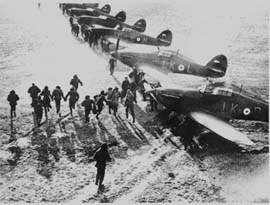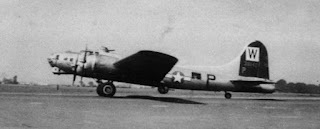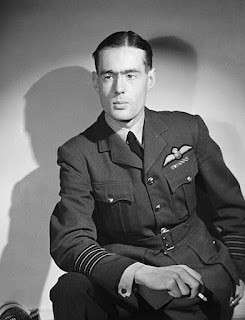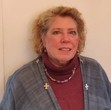Helena P. Schrader's Blog, page 21
April 15, 2022
Mastermind behind the British Victory in the Battle of Britain - ACM LORD DOWDING
To the extent that we consider the Battle of Britain pivotal to Allied success in WWII, the mastermind behind the RAF's success deserves far more credit and fame than he has been given to date. Air Chief Marshal Sir Hugh Dowding, known by contemporaries as "Stuffy" Dowding, may have lacked charisma -- but not vision.
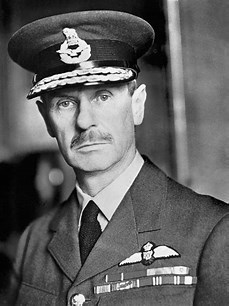
ACM Dowding was not only the commanding officer of Fighter Command during the entire Battle of Britain, he was the man who had envisioned, created, shaped and molded Fighter Command into an instrument capable of withstanding the onslaught of the Luftwaffe in 1940. Dowding had been instrumental in Training Command in the inter-war years, and for six years headed the Supply and Research Office of the Air Ministry, in which capacity he was instrumental in fostering the development of radar. He was directly responsible for inviting private tenders for ‘the fastest machines they could build’ resulting in the design of the Hawker Hurricane and Supermarine Spitfire respectively. (Hurricanes are in the photo above; below the Spitfire.)
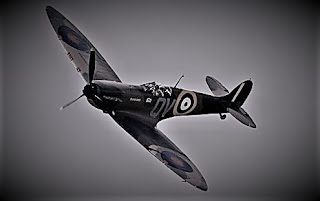
But technology and weapons are nearly worthless if they are improperly used or misused. Neither fighter nor radar would have saved England from invasion in 1940, if the institutional structures and fundamental strategy for the defense of Great Britain had not be evolved by Sir Hugh Dowding. In 1936, Dowding was appointed the first commander of the newly created Fighter Command. In this capacity, he ensured both the establishment of coastal radar stations (then known as RDF), and evolved the system of communications and control that linked that early warning system to the fighters that needed to respond.
The complex yet efficient system in which radar stations were connected by telephone directly with Fighter Command HQ, where a Filter Room sifted through and made sense of the plethora of reports and this information was converted into comprehensible plots on a map, was Dowding’s invention. The segmentation of British airspace into sectors, each protected by designated squadrons controlled and directed from a Sector Airfield with its own Control Room, was Dowding’s concept.
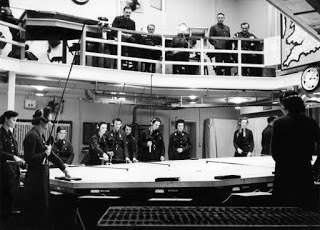
All the technology in the world and the best fighters would have been worthless it the information was not brought together in a timely and coherent manner that enabled commanders to make intelligent and informed decisions. The RAF did not — anc could not build with the resources at hand — sufficient fighters to patrol the skies of the UK at all times. Without this system and the military doctrine behind it, Fighter Command would have been overwhelmed in 1940.
Dowding also demonstrated foresight in advocating the training of women on radar and employing them as plotters and filterers. Women (WAAF) proved to be extremely competent, reliable and unflappable.
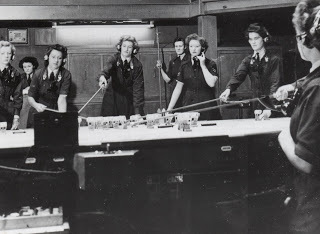
Last but not least, Dowding must be given credit for withstanding the immense political pressure to send more and more RAF fighter squadrons to France as the German offensive systematically overwhelmed French defenses. Had Dowding not vehemently insisted on the need to retain sufficient squadrons in Britain to ensure the defense of the realm, too many British aircraft and pilots might have been squandered in the lost Battle of France.
For all these reasons, Dowding deserves to be remembered as one of the greatest military leaders of the 20th century along with Air Vice Marshal Park, who commanded 11 Group during the Battle — but that is a different story and would require a second entry.
Dowding has only a cameo role in "Where Eagles Never Flew" which views the battle from the perspective of the frontline rather than HQ.
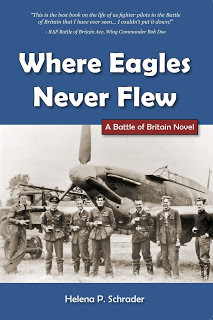 Buy now - Itasca!
Buy now - Itasca!Buy on Amazon.com!Buy on Amaxon.co.uk!Buy on Barnes and Noble
My novels about the RAF in WWII are intended as tributes to the men in the air and on the ground that made a victory in Europe against fascism possible.
Lack of Moral Fibre, A Stranger in the Mirror and A Rose in November can be purchased individually in ebook format, or in a collection under the title Grounded Eagles in ebook or paperback. Find out more at: https://crossseaspress.com/grounded-e...
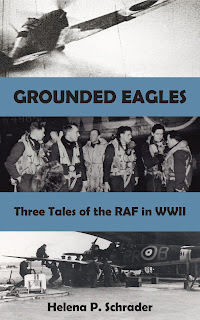
April 8, 2022
The Women Who Made the RAF and the Luftwaffe Successful
The success of an air force is not exclusively attributable to its pilots. As noted last week, ground crews are nearly as important, and command and control probably rates third in the hierarchy of factors contributing to success. Many other factors play a role as well, and both the British and the Germans learned early in WWII that some of the best recruits for the complex and technical tasks associated with support functions in modern air forces were female.
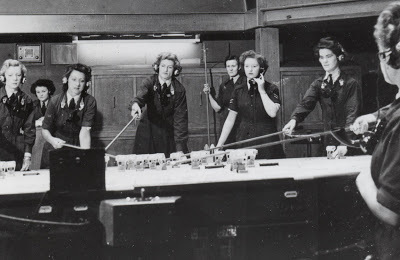
The RAF’s positive attitude towards women was exceptional among the services -- and light years ahead of the USAAF. The RAF actively encouraged the establishment of a Women’s Auxiliary, which by the end of the war served alongside the RAF in virtually all noncombat functions.
Even before the start of the war, however, the vital and highly technical jobs of radar operator and operations room plotter, as well as various jobs associated with these activities, were identified as trades especially suited to women. The C-in-C of Fighter Commander, ACM Dowding, personally insisted that the talented women who did these jobs move up into supervisory positions – and be commissioned accordingly.
During the Battle of Britain over 17,000 WAAF served with the RAF, nearly 4,500 of them with Fighter Command. A number of WAAF were killed and injured and six airwomen were awarded the Military Medal during the Battle.
Surprisingly, despite Nazi ideology about the place of women being exclusively in the home, the Wehrmacht was also forced to rely increasingly on women auxiliaries. The expansion began after the dramatic victories in the West in May/June 1940 and continued throughout the war. The number of women serving with the Wehrmacht increased from roughly 35,000 women in uniform in 1941 to over 150,000 when Germany surrendered. General conscription for women, industrial and military, was introduced in Germany after the loss of an entire Army at Stalingrad in early 1943, but the bulk of the women serving in the women’s auxiliary forces before 1945 were volunteers. These women are far too often forgotten entirely in accounts of the Second World War.
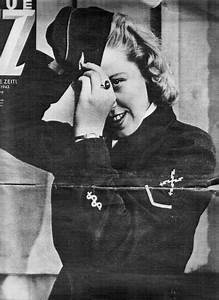
Women auxiliaries play a significant role in Where Eagles Never Flew. Find out more here .
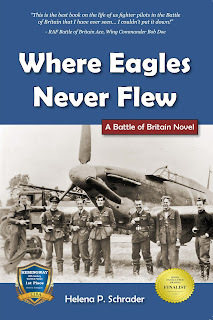
April 1, 2022
An Air Force is only as good as its Ground Crews
It was not the pilots alone who won the Battle of Britain.
The RAF worked hard to ensure that its pilots were supported by some of the best trained ground crews in the world.
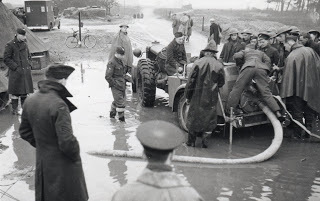
With an ‘apprentice’ program, the RAF had attracted technically minded young men early and provided them with extensive training throughout the inter-war years. In some ways, ground crews were better educated than many pilots.
Under the circumstances and given the fact that many pilots came up from the ranks themselves, it is hardly surprising that the relations between pilots and crews were on the whole excellent. The RAF had a notoriously relaxed attitude towards discipline in any case, and this further worked to break down barriers.
Last but not least, at this stage of the war, individual crews looked after individual aircraft and so specific pilots. The ground crews identified strongly with their unit – and ‘their’ pilots. After the bombing of the airfields started in mid-August, the ground crews were themselves under attack, suffering casualties and working under deplorable conditions – often without hot food, dry beds, adequate sleep and no leave. The ground crews never failed their squadrons. Aircraft were turned around – rearmed, re-fuelled, and thoroughly checked – in just minutes.
Where Eagles Never Flew is a tribute to the men and women who were engaged in this crucial conflict. Based on first-hand accounts by pilots and other participants as well as retrospective historical analysis, this novel recreates the tense atmosphere of this dramatic summer. It allows the reader to see unfolding events through the eyes of characters involved both in the air and on the ground and on both sides of the Channel.
Click here to see a video teaser of Where Eagles Never Flew
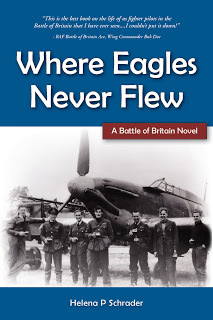 Buy now - Itasca!
Buy now - Itasca!Buy on Amazon.com!
Buy on Amaxon.co.uk!
Buy on Barnes and Noble
March 25, 2022
No Victory without a Price - The Cost of even the most "Economical" Wars
In retrospect — or from the perspective of the government — the price of victory in the Battle of Britain was clearly affordable. During the Battle of Britain, the RAF lost 1,023 aircraft compared to the Luftwaffe’s loss of 1,887 aircraft. In fact, due to the dramatic increases in aircraft production, the RAF ended the Battle with more front-line fighter aircraft than it had at the start of the Battle. In contrast, the Luftwaffe’s fighter strength declined by 30%. The imbalance in personnel losses was even greater: while the Luftwaffe lost 2,698 airmen during the battle (killed, wounded and captured), the RAF lost 544 pilots killed. Yet these statistics are deceptive.
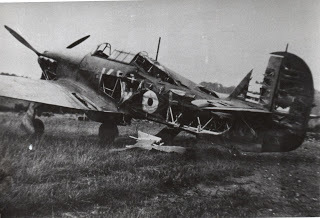
It must be remembered that pilots at the time were highly trained specialists who could not be easily or rapidly replaced. While the numbers were small compared to the total population, the pilot losses nevertheless represented roughly 40% of Fighter Command’s strength.
What this meant, is that from the perspective of the participants, chances of survival were barely greater than 50%. The situation was aggravated by the fact that, as a rule, the more experienced pilots had a 5-6 times greater chance of surviving than did the replacement pilots coming into the front line with very little flying and no combat experience. The most critical period for a replacement pilot was his first fortnight in the front-line squadron.
In consequence, there were a significant number of pilots who fought throughout the Battle (four full months) and survived, but many other pilots who did not survive four hours. This meant, in effect, that a smallish core of experienced pilots often watched waves of replacements arriving and then being shot-down in a short space of time. Meanwhile, sheer exhaustion wore down even the experienced pilots and by the end of the Battle it was the Squadron Leaders, Flight Lieutenants and Section Leaders who were falling victim as a result of inattention, and “sloppy flying.”
For an individual squadron engaged in the Battle of Britain the pilots who were seriously injured and hospitalised also had to be replaced, so the effective casualty rate (killed and wounded) at squadron level was closer to 70% than 50%. This situation forced ACM Dowding and AVM Park to pull entire squadrons out of the front line (i.e. 11 Group) and replace them with new squadrons when a certain — albeit very subjective — level of exhaustion and depletion had been reached. Altogether 16 squadrons were withdrawn from 11 Group in the one month between August 8 and September 8, 1940.
The problem with this rotation was that the replacement squadrons — like replacement pilots — were far more likely to suffer casualties and far less likely to destroy enemy aircraft than the tired but experienced squadrons. This was because the replacement squadrons often had no pilots with experience of the combat conditions reigning in Southeast England at the time. Without experienced leaders, these fresh squadrons were often mauled badly during their first encounters with the Luftwaffe. It was not uncommon for these squadrons to lose 5 – 6 aircraft and 3 – 4 pilots in a single engagement.
Where Eagles Never Flew is a tribute to the men and women who were engaged in this crucial conflict. Based on first-hand accounts by pilots and other participants as well as retrospective historical analysis, this novel recreates the tense atmosphere of this dramatic summer. It allows the reader to see unfolding events through the eyes of characters involved both in the air and on the ground and on both sides of the Channel.
Click here to see a video teaser of Where Eagles Never Flew
 Buy now - Itasca!
Buy now - Itasca!Buy on Amazon.com!
Buy on Amaxon.co.uk!
Buy on Barnes and Noble
March 18, 2022
The World Loves an Underdog - The Nazi Juggernaut against a "Few" British Amateurs
As the war in Ukraine enters its fourth week, the ability of the out-numbered and out-gunned Ukrainians to withstand the Russian juggernaut increasingly attracts world admiration. People love it when the underdog defies expectations and stops a bully.
The Battle of Britain had that quality as well.
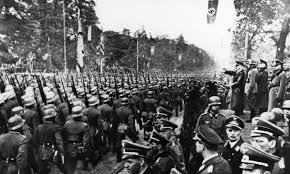
In the summer of 1940, the RAF stood against an apparently invincible enemy, a juggernaut of seemingly huge proportions, while RAF Fighter Command was tiny -- and largely composed of 18-22 year-old amateurs hastily inducted! Even including the foreign pilots flying with the RAF, there were only roughly 1,200 trained fighter pilots. (Numbers varied due to training, casualties and recruiting.) They were anything but "cannon fodder." Although very few of them were "regulars," because the process of learning to fly to the proficiency required took more than a year, fighter pilots represented a cadre that could not be readily replaced. The RAF had to beat the Luftwaffe with the few men it had.
Churchill – as so often – captured the sentiment of his countrymen when he claimed that “never in the field of human conflict has so much been owed by so many to so few.” This image of a small “band of brothers” standing up to a massive and invincible foe in a defensive battle for their homeland was reminiscent of other heroic battles – Henry V at Agincourt, Edward the Black Prince at Poitiers, Leonidas and his 300 at Thermopylae. Such battles, pitting a few defenders against a hoard of enemy, have always appealed to students of history and readers of historical fiction like almost nothing else.
It would be easy to imagine Churchill's "Few" as a tiny elite like the knights of earlier centuries or the Spartan guard with Leonidas at Thermopylae. After all, this was a Britain that was still overwhelmingly white, Christian and intensely class conscious.
Yet RAF Fighter Command was surprisingly diverse for the period. Of the nearly 3,000 RAF pilots who flew at least one sortie during the Battle of Britain, only 80% were British citizens. Twenty percent came from the Dominions and/or other Allied countries. The largest number of foreigners to participate in the Battle were Polish, accounting for 145 pilots, and the second largest foreign contingent flying for the RAF came from New Zealand with 126 pilots. Pilots also came from Canada, Czechoslovakia, Australia, Belgium, South Africa, France, the United States, Ireland, Rhodesia and Jamaica.
Even more astonishing, however, is that fully one third of the pilots who flew in the Battle of Britain were Sergeants. That is, they were not the children of privilege, not the scions of the aristocratic families or the product of “Oxbridge.” The Sergeant Pilots of the RAF were men with more mundane backgrounds, men without the ‘right accent,’ who had not gone to public schools, and sometimes had even left school at 14 or 15.
This was because since its inception, the RAF had actively encouraged recruitment from all sectors of society, intentionally breaking with the rigidly class-conscious traditions of the Royal Navy and Army. The RAF had provided scholarships to the Royal Air Force College at Cranwell for exceptional young airmen and apprentices. It had launched a special program to encourage ground crews to receive pilot training. The RAF Volunteer Reserve was established to enable young men still in civilian life without the means to finance flying lessons to learn to fly at RAF expense. These pilots almost invariably came from the classes of society whose sons did not traditionally go to public schools, University or the Officer Corps.
In the Battle of Britain, pilots of the VR flew, drank and joked alongside the titled and privileged pilots of the University and Auxiliary Air Squadrons and the regulars, who had graduated from Cranwell. Literally, the sons of dukes and miners served in the same squadrons, fulfilling the same duties, taking the same risks, and reaping the same rewards. Most of the Sergeant Pilots of the Battle of Britain who survived were later commissioned, and often rose to senior command.
Where Eagles Never Flew is a tribute to the men and women who were engaged in this crucial conflict. Based on first-hand accounts by pilots and other participants as well as retrospective historical analysis, this novel recreates the tense atmosphere of this dramatic summer. It allows the reader to see unfolding events through the eyes of characters involved both in the air and on the ground and on both sides of the Channel.
Click here to see a video teaser of Where Eagles Never Flew
 Buy now - Itasca!
Buy now - Itasca!Buy on Amazon.com!
Buy on Amaxon.co.uk!
Buy on Barnes and Noble
March 11, 2022
Some Battles are Decisive - Remembering the Battle of Britain
Watching Ukraine fighting alone against a brutal, autocratic aggressor reminds me viscerally of the Battle of Britain. I cannot help but imagine Ukrainian pilots "scrambling" and fighting desperate battles, while their bases -- and their homes -- are bombed around them.
Although very different, the parallels to the Battle of Britain are nevertheless striking. In 1940 it was Britain, now it is Ukraine that stands alone. Again the United States is on the sidelines -- if for very different reasons.
As a historian, I firmly believe that remembering the past helps us understand the present. Studying the past can help us see options, remember hazards, and draw strength from examples of courage and endurance in adversity. However, in this and future posts, I will speak only about historical events. I leave it to the reader to consider parallels to the present and note differences of significance -- which may alter the outcome.
The Battle of Britain did not win or end the war against Nazi Germany. It would take five more grim and grueling years of conflict before Hitler was finally defeated. The Second World War first spread across the entire northern hemisphere and consumed millions of lives before it was finally over. Yet the Battle of Britain was the imperative first step toward Allied victory. It brought Hitler’s aggression to a halt for the first time since he had come to power in Germany in 1933.
For Hitler, the failure to defeat the Royal Air Force in the summer of 1940 was viewed more as an annoyance rather than as a major strategic set-back. He had long declared his preference to have Great Britain as an ally. He had hoped the British would not ‘interfere’ with his invasion of Poland. He had expected the British government to sue for peace after the fall of France. When the Luftwaffe proved incapable of creating the conditions for an invasion, Hitler turned his attention back to his long-held goal of invading the Soviet Union. The war against the Soviet Union was Hitler’s passion; the war against the British Empire was an irritating complication about which he lost little sleep. To this day, most Germans have never even heard of the Battle of Britain, and if they have, they attribute to it no major significance.
Yet for Britain, the United States, Occupied Europe, and later even the Soviet Union, the significance of the Battle of Britain can hardly be over-stated.
Although Hitler had not expected it would be necessaryto invade England, he had been prepared to do so. Likewise, while neither the German Navy nor Army were keen about a cross-channel invasion, they dutifully made (or pretended to make) the necessary preparations. Their reluctance would not have stopped Hitler from ordering the invasion of England had he chosen to do so. However, it was agreed within the German High Command that the Luftwaffe would pave the way for an invasion by establishing air superiority over Britain. It was hoped — and perhaps assumed — that the air attacks would drive the British government to the negotiating table.
It was only as the costs of the air fighting mounted and the British government remained intransigent that Hitler made the decision to postpone the invasion indefinitely. This decision was taken on September 17, mainly as a result of the air fighting on September 15. The furious and tenacious defense of English airspace on September 15, 1940 proved that the RAF was far from defeated.
The victory was not immediately apparent. The Luftwaffe continued to attack Britain on a smaller scale by day and neither German troops nor barges were withdrawn from the channel ports until the spring of 1941. Furthermore, the night “Blitz” of London continued savagely throughout the winter. The British people did not feel safe from invasion until the Wehrmacht had turned its attention to the Soviet Union in the summer of 1941.
Yet the RAF had failed to discourage Hitler from his plans to invade Britain, the course of the war would inevitably have been different. A German invasion would have been launched. Whether the Royal Navy, seriously weakened by the losses incurred at Dunkirk and dangerously over-stretched trying to protect the Atlantic lifeline, could have stopped it remains debatable. Certainly, the British ground forces lacked tanks and artillery for fighting the heavily mechanized Wehrmacht, if it successfully came ashore. Churchill was not only being rhetorical when he spoke about fighting a guerrilla war against the invaders!
Thus, in retrospect, we know that the Battle of Britain is what saved the British Isles from a Nazi invasion and very likely from Nazi occupation. What is often forgotten nowadays is that it was a very near-run thing. The outcome teetered in the balance day after day. It was also a victory won by an extraordinarily limited number of combatants — Winston’s Churchill’s “Few.” Yet they were not entirely alone in this vital struggle. They were supported by ground crews and controllers, by medical, clerical and catering staff -- and by the women they loved.
Where Eagles Never Flew is a tribute to the men and women who were engaged in this crucial conflict. Based on first-hand accounts by pilots and other participants as well as retrospective historical analysis, this novel recreates the tense atmosphere of this dramatic summer. It allows the reader to see unfolding events through the eyes of characters involved both in the air and on the ground and on both sides of the Channel.
See a video teaser of Where Eagles Never Flew
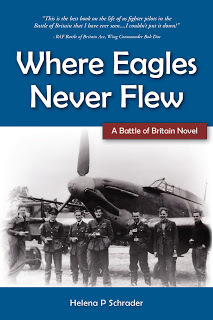
March 4, 2022
FORGOTTEN HEROES: FIRST LIEUTENANT DOUGLAS RAYMOND STARRETT
Today I conclude my series on "Forgotten Heroes of the Air War 1939-1945" with a guest entry from Susan Martin of Cumberland Maine. Susan writes about her father, Lieutenant Douglas Starrett, who commanded a B-17 of the US Eighth Air Force in 1944-1945. Like "Stevie's" story, his tale is less about exceptional acts of courage and more about the spirit of dedication and commitment that so often characterized the men who flew for the Allies in WWII.
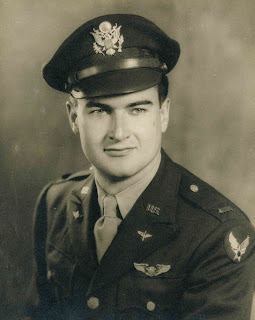
"What does it matter how you feel about that? It has to be done."
"Self-discipline!"
When I was growing up, I never thought to ask why or how my father came to use such strong statements with me. Or why, whenever something went wrong, or in an emergency, my Dad got very quiet, very controlled and took care of everything. Only later did I start to think it had something to do with the fact that he had been the captain of a bomber plane in WWII. When he was alive, I never asked him about his experiences — and he never told me anything either.
Yet I vividly remember one time as a teenager coming upon him watching a black and white movie on TV. His jaw was tensing, his fists were clenching and he didn't even know I was looking at him. Quietly, I left the room, found my Mom and asked her what was wrong with him. Her answer: "Oh he's just watching 12 O'Clock Highagain!" Of course, I watched it myself as soon as I could. I was shocked at the combat footage (some actually filmed during air battles) and came away in a bit of awe...wondering how anyone could function, let alone come back alive. My father was one who did, and this is his story.
My father was born in April 1920 in Framingham, Massachusetts, the oldest son of Arthur Starrett, the president of L.S. Starrett Tool Company. He was followed by a brother and sister. After completing high school in Athol, Massachusetts, Dad went to Worcester Academy in 1937 for one year and then to Dartmouth College. He had not yet completed his junior year when the Japanese attacked Pearl Harbor and Hitler declared war on the United States. Returning home after completing his junior year exams at Dartmouth College, he informed his father that, like many other young men at that time, he did not intend to return to college but was going to join the Air Force instead. It ended up being an all-night-long fight with his father Arthur, but my Dad won the fight. He joined the USAAF.
He also got married to my mother, Janet Nichols. He was 21 & she was 22. She had just graduated Skidmore College. After they got married, he took my Mom with him to Florida while he went through pilot training. Married airmen at that time could bring their wives and they lived off-base in apartments.
My father won his wings at Freeman Field, Indiana in March 1944. Further, training followed, until he was fully qualified on the four-engine B-17 bomber. On completing training, he was assigned to the USAAF 8thAir Force. The legendary “Mighty Eighth” was based in England and leading the U.S. strategic bombing efforts against Nazi Germany.
My mother could not accompany my father overseas. She chose to live with her parents, while my father deployed to England. It must have been a scary time for both of them. He was facing the enemy day-after-day and with it the constant threat of death. All my mother could do was wait for his letters — while reading everyday how many B-17s had been shot down. She knew the risks all too well — and so did he. According to my mother, they had refrained from starting a family before the war because my Dad didn't want to leave her a widow with a child. I would not be born until 1946.
My father joined the 486 Bombardment Group, Eighth Air Force, Third Air Division, stationed at Skipton Airbase. He was lucky to arrive so late in the war. In 1943, airmen flying with the USAAF from England had only a one in four chance of completing their tour. Average life expectancy was 15 missions, and a tour was 25. By the time my father completed training, however, the long-range fighters, the P-47 Thunderbolt and P-51 Mustang, had joined the fight, and the Luftwaffe had largely been destroyed. Chances of survival had improved so much that the USAAF increased the length of a tour from 25 missions to 35. And while the threat from the Luftwaffe had decreased, the German anti-aircraft batteries, the infamous “flak,” was as bad or worse than ever. As captain, my Dad was the pilot and if it were damaged, it was his job to stay in his seat and try to keep the plane level and on an even keel so his crew could bail out. He would be last to man to parachute out — assuming the plane didn’t spin out of control as soon as he stopped flying it, that is!
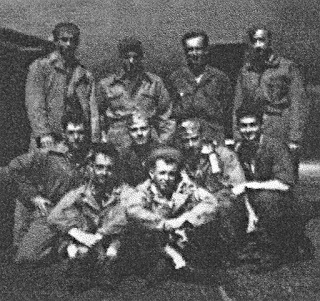 The above photo shows my Dad and his crew. He is in the middle row, the dark-haired, smiling guy on the far right. Below is their B-17, “Lil Butch.” My Dad flew all of his 35 missions in it and it always brought them home safe. My Dad finished his tour on March 23, 1945.
The above photo shows my Dad and his crew. He is in the middle row, the dark-haired, smiling guy on the far right. Below is their B-17, “Lil Butch.” My Dad flew all of his 35 missions in it and it always brought them home safe. My Dad finished his tour on March 23, 1945.On March 30, just a few days after Dad flew his last mission, his former B-17 went down over Hamburg. According to squadron records, one of the aircraft wings broke off and it went into a steep dive. Only two crewmen survived to become POWs. Yikes !!! It guess it was bad karma for the new crew to change the name of the plane my Dad piloted on 35 missions and which had always brought him and his crew home from "Lil Butch" to “Rodney the Rocks.”
Not that my father never had problems. I remember my Dad saying that the B-17's, the Flying Fortress, could take a lot of hits and still remain flying. I later learned that he had to land once in France because he was so badly shot up that he knew he couldn't make it back over the English Channel. An account of this appeared in his local hometown news paper on March 19, 1945. The headline read: "Athol Pilot Saves Fort" "Lt. Starrett Lands Damaged Bomber in Nick of Time"
To paraphrase, his gasoline was just about gone, the navigational equipment and radio destroyed, but flying in bad weather through a heavy cloud cover, he managed to land his plane and crew safely on a field not too far from Paris. He had flown through heavy flak over railroad yards in Munich Germany, dropping his bombs but being shot up pretty badly. "We hit that runway at the right minute" said my Dad. "The needles on those gas gages were kicking around like they wanted to jump out and do a tap dance on the instrument panel"
He, his crew and plane stayed overnight on that field for emergency repairs and service so they could make it back across the Channel the next day. Before they flew back to Britain, a local priest brought a group of over 60 children from a nearby village. They had often seen these large armadas of B-17s flying over their village but had never seen one close-up. Dad's crew took the children out to their plane where they excitedly swarmed all over it, asking questions in French and broken English. They were particularly excited to learn that each bomb painted on the big bomber's nose indicated one successful attack on a war target in Germany. When the bomber finally took off down the runway, the kids cheered, waved and gave the V-Sign.
After the war, my Dad did not go back to Dartmouth but went right into the 4-year apprentice toolmaker's program at L.S. Starrett Co. Back then, even if you were aiming to advance up the ladder, a college degree wasn't as important as it is now — at least that was my Mom’s explanation for why my Dad never finished college. I think that his war experiences also matured him, and he felt that he wasn't a college boy anymore. He wanted to get on with his career, married life and start a family. I was born in 1946, a year after he left the Air Force, followed by my sister Sarah and brother Douglas.
Dad's Father Arthur was not going to just put his son into the executive office. Instead, my Dad had to learn about the tools the factory sold at first hand. He had to work in all the departments as he worked his way up the ladder. Eventually he became President and the CEO of the company. He established overseas branches in Scotland & Brazil and was still working at the time of his death at 81 years old in Nov. 2001.
Once as a teenager, I was on a commercial flight with Dad, and it really got rough and bumpy. I was scared and told my Dad. He said, "What are you afraid of? No one is shooting at us." Then I asked him, "Dad you kissed your wedding ring when we took off...how come?" He replied, “I kissed the ring every time we took off for a bombing run over Germany, and I always came back!"
Susan Starrett Martin, age 75, Cumberland Maine USA
My novels about the RAF in WWII are intended as tributes to the men in the air and on the ground of whatever nationality that made a victory in Europe against fascism possible. Find out more at:https://www.helenapschrader.com/aviat...
Lack of Moral Fibre, A Stranger in the Mirror and A Rose in November can be purchased individually in ebook format, or in a collection under the title Grounded Eagles in ebook or paperback. Find out more at: https://crossseaspress.com/grounded-e...

Where Eagles Never Flew was the the winner of a Hemmingway Award for 20th Century Wartime Fiction and a Maincrest Media Award for Military Fiction. Find out more at: https://crossseaspress.com/where-eagl...
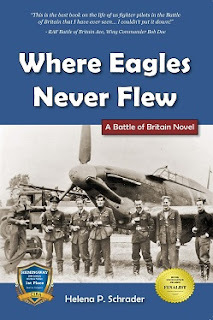
February 25, 2022
FORGOTTON HEROES: LEONARD CHESHIRE, VC, OM, DSO & TWO BARS, DFC
In the course of WWII, 28 men won Britain's highest award for bravery, the Victory Cross, while flying with the RAF. All demonstrated remarkable devotion to duty and physical courage, and sixteen of them gave their lives so that we will never know what they might have done in peace. Of the survivors, however, one man stands out even in this distinguished company: Leonard Cheshire.
Cheshire stands out on three counts. First, he combined personal courage with devotion to the welfare and well-being of the men under his command. Second, he was unconventional and innovative in his thinking and approach to problems, significantly impacting Bomber Command tactics at a critical time. Third, he devoted his life after the war to helping people, first by learning nursing and personally caring for others, later by establishing foundations dedicated to aiding those with disabilities -- which still exist today. In short he combined courage with compassion to an unusual degree. A short biography follows.
Geoffrey Leonard Cheshire was born into the British ruling elite, the son of a barrister and legal scholar. He went to the best schools and attended Oxford University where he studied law, graduating in 1939 — albeit not with first class honors as was expected by his family. Yet more important than his academic activities in this period is that he won a bet that he could walk all the way to Paris starting only with a few pennies in his pocket. Equally important, he visited Germany in 1936 staying with Ludwig von Reuter, a highly decorated German naval officer responsible for scuttling the German fleet at Scapa Flow in June 1919. During his stay in Germany, Cheshire attended one of Hitler’s rallies and demonstratively refused to give the Nazi salute. Last but not least, while studying at Oxford, Cheshire joined the Oxford University Air Squadron and learned to fly. As a result, he already held a commission as a pilot officer at the start of WWII.
At the outbreak of the war, Cheshire was summoned for active duty and assigned (to his disappointment) to Bomber Command. After operational training, he was promoted to Flying Officer and posted to 102 (Whitley) Squadron in April 1940. Cheshire related in his memoirs that at the time he was afraid of not measuring up. He credits his later success to the intense mentoring he received from Hugh “Loffty” Long, with whom he initially flew as Second Pilot. In addition to giving him opportunities to fly while on operations, Long demanded very high standards and drilled Cheshire on procedures blindfolded while on the ground. Long also made Cheshire become familiar with the duties of the gunner, navigator and wireless operator, making him sit in their places and see the world from their perspective. Cheshire flew ten operational flights as “second dickey” to Long before being given command of his own aircraft in June 1940.
Cheshire earned his first decoration on the night of Nov. 12/13 1940. On finding the target (the synthetic oil plant at Wesseling) obscured by fog, Cheshire decided on his own initiative to drop his bombs on the railway yards of Cologne. Unfortunately, his aircraft was bracketed by flak. Cheshire was temporarily blinded and a huge hole was torn in the aircraft, igniting one of its flares. On fire, the aircraft went into a steep dive. While Cheshire regained control of the aircraft, his crew fought the fire. When the fire was extinguished, a hole stretched along the port side from the wing almost to the after hatch. However, both engines were still working and the aircraft seemed to be flying well enough, so Cheshire decided to make a renewed approach on the target and drop his bombs. His tour with 102 Squadron ended in January 1941 and he immediately volunteered for a second tour.
Cheshire’s next tour was with 35 Squadron, which had just been outfitted with the four-engine Halifax bomber. He flew on seven operations against Berlin in this period and was promoted to Flight Lieutenant in April 1941. When the squadron was stood down in May while Bomber Command attempted to redress design flaws in the Halifax, Cheshire took the opportunity to volunteer for a temporary posting to the Atlantic Ferry Organization. This gave him an opportunity to see a little of America. His return, however, was delayed by bureaucratic glitches, so when he finally flew a Hudson back to England, it was to discover on arrival that all but one of his crew had been killed on an operation during his absence. Although he was badly shaken by these losses, he formed a new crew and completed his tour with 35 Squadron in early 1942 with a total of 50 operational sorties.
Cheshire next served as a flying instructor at an operational training unit, but continued to fly on operations when calls were made for a “maximum effort” — something that happened frequently in this period shortly after AVM Arthur Harris took over Bomber Command. During a sortie to Berlin in which his brother was also flying, his brother’s aircraft went missing. Meanwhile, Cheshire had been promoted to Squadron Leader and flight commander.
Whether by chance or intent, shortly afterward, the RAF saw fit to appoint Cheshire CO of his brother’s former squadron, No 76. He took over at a time when the squadron had been badly decimated and morale was low. Cheshire tackled the moral problem by employing an extremely personal leadership style. He made a point of knowing the names of everyone on his squadron — officers and other ranks, air and ground crew both. He took time to talk to them, to become familiar with their personal lives. This approach earned Cheshire praise, particularly from the “other ranks” who served under him. Despite the RAF’s vaunted meritocracy, many men without wings felt keenly that the RAF was still a pilot’s club. Cheshire, they claim, was one of the few senior officers (he was by then a Wing Commander) who showed as much interest and respect for a gunner or a rigger as he did for a pilot.
Furthermore, although ordered to fly no more than once a month unless “absolutely necessary,” Cheshire ignored those orders and flew every difficult operation. When flying, he either flew Second Pilot to a sprog pilot to help build the confidence of the newcomers, or he flew first pilot with an experienced crew while leading a particularly risky operation. Just as he disobeyed orders about flying less, he also ignored orders he thought were stupid — such as flying at 2,000 feet over concentrations of flak.
Yet Cheshire distinguished himself from other conscientious commanders by going beyond good leadership and setting a good example. Cheshire also tried to solve the increasingly worrying design problems with the Halifax. Halifax losses were excessive. Few could return on three engines (unlike, for example, the Lancaster that could fly on two quite well and occasionally made it home on only one engine). Equally dangerous was that the Halifax appeared unstable in a “corkscrew,” the standard evasive tactic for bombers attacked by fighters. Cheshire personally joined the test pilot looking into the problems in an effort to understand the situation better. After this experience, he ordered modifications to his squadron’s Halifaxes to make them lighter and so able to fly higher and faster.
At the end of his third tour, Cheshire was promoted to Group Captain at the age of 25; he was the youngest Group Captain in the RAF at the time. Effective 1 April 1943, he was appointed Station Commander at Marston-in-Marsh. It may have seemed like an April fool’s joke to him, as he immediately encountered difficulty with red tape and a bureaucratic mentality among the permanent staff that was alien and anathema to him. He had hardly started his new job before he started trying to get out of it again — and back to operational flying. Maybe out of frustration, he wrote and published his first book, Bomber Pilot, during this phase of his life.
In September 1943, the C-in-C of 5 Group Ralph Cochran asked Cheshire if he would be willing to assume command of No 617 Squadron, famous as the “Dambusters.” Although such a posting would require him to surrender his promotion and revert to the rank of Wing Commander, Cheshire jumped at the opportunity. Cochran required him to do a conversion course onto the Lancaster before starting, which Cheshire did with marked humility. Other trainees remember him meticulously asking questions especially of men flying in other trades (e.g. Flight Engineer, Bomb Aimer etc.)
Cheshire had been recruited by Cochrane to help solve a pressing problem. With their backs increasingly to the wall, the Germans had unleashed their creativity to develop four devilishly advanced and potentially game-changing weapons. Two of these were early forms of missiles, or “flying bombs,” the familiar V1s and V2. The third was huge, long-range guns being installed in the Pas-de-Calais, and the fourth was the mostly battery-powered XXI-type submarines with underwater speeds faster than most merchantmen. All of these super-weapons were being constructed and installed in “hardened” sites protected by reinforced concrete meters thick. The RAF had to find a means to penetrate those concrete walls and destroy the weapons underneath. The engineering genius Barnes-Wallis, famous for developing the bouncing bombs that had destroyed the Ruhr Dams, had already come up with a new bomb. This so-called “Earthquake” bomb if dropped from 18,000 feet or more could reach supersonic speeds and penetrate meters thick concrete. The problem was that the bomb was only effective if delivered very precisely — within 12 meters of the target.
Cheshire’s challenge was to find a way to mark a target so precisely that bombs could be delivered within 12 meters from 18,000 feet or more. The marking techniques then in use were woefully inaccurate as an attempt by 617 to take out a V-1 site in January 1944 proved. 617 Squadron led by Cheshire succeeded in dropping all their bombs within less than 100 yards of the target, but the Pathfinder that had marked the target had dropped the flare 350 yards off the target and all the subsequent accuracy had been in vain.
Using this example, Cheshire convinced AVM Harris to allow him to develop his own marking techniques. Eventually, after intensive experimentation on the bombing range, Cheshire and the pilots working with him developed a technique involving a combination of illuminating flares that enabled a low-flying aircraft to deliver a marking flare very precisely by dive-bombing down to 100 feet. Cheshire proved the concept with — of all aircraft! — a Lancaster.
Cheshire and 617 Squadron demonstrated the effectiveness of the technique in a raid on the aero-engine factory in Limoges, France. Cheshire first flew over the factory at 20 feet to warn the French workers. They got the hint and ran out. Then he dropped the marker flare on the roof of the factory and called in the remaining aircraft of 617 one at a time. The factory was obliterated without a single casualty on the ground.
Further experience showed that the marking could be accomplished better by a lighter and more maneuverable aircraft such as the Mosquito, and Cheshire was loaned several that he then employed highly effectively on a variety of raids including Munich, V1 and V2 sites, and E-boat pens. When the RAF later took Cheshire’s borrowed Mosquitos away, he obtained a Mustang from the USAAF — and flew it for the first time on June 25 to lead a daylight raid against a launch site for V1 flying bombs. His ground crew literally finished assembling the Mustang after the Lancasters of 617 had already taken off. Cheshire climbed into the Mustang and took off without a test flight to overtake his bombers and place the marker flares. He arrived on schedule and succeeded in marking the target accurately. The V1 site was destroyed.
On 6 July 1944, Cheshire led 617 in an attack on the V3 site and utterly destroyed it, removing this “wonder weapon” from Hitler’s arsenal altogether. The following night, July 7/8 Cheshire flew his 100th operational sortie. In his Mustang he marked a V1 and V2 storage site hidden in the caves at St. Leu d’Esserent, and 617 Squadron using Barnes-Wallis “Tallboy” bombs caused the caves to collapse. Immediately following, he was taken off operations on Cochrane’s orders and command of 617 Squadron was turned over to another officer.
Cheshire was awarded the Victoria Cross for his four years of outstanding service and four operational tours. Characteristically, as his investiture at Buckingham Palace, which did not take place until Oct. 1945, Cheshire told King George VI that the warrant officer receiving the VC at the same time, Norman Jackson, should receive his VC first. Jackson, a Flight Engineer, had crawled out of the cockpit of a damaged Lancaster with a fire extinguisher in order to put out a fire to one of their engines that threatened to reach the fuel tanks. He was badly burned in the attempt and blown off the wing, but survived in German captivity.
Cheshire served as one of the official British observers at the bombing of Nagasaki, and six months later in January 1946 resigned from the RAF due to disability. Immediately, he became involved in an unstructured charitable venture, namely turning his home into a “colony” for veterans and war widows, in which the inhabitants lived together in a community to help transition back to civilian life. Demand for space was great, so he bought a mansion from his aunt, but the communal experiment did not work out and closed in 1947. One of the participants, however, had developed cancer and asked Cheshire for land where he could park a caravan until he “recovered.” Cheshire instead invited him into his home and learned nursing skills to look after him as he was, in fact, dying.
Soon there were others. Some came because they were terminally ill. Some came to help. Finances were improvised. Cheshire realized the situation was not sustainable and so sought to institutionalize his work by registering a charitable organization, the Cheshire Foundation Homes for the Sick. The concept was that volunteers in a community would come together, identify suitable accommodation and raise funds. Today known as the Leonard Cheshire Disability charity, the registered aims are: "to provide effective and efficient community-based services to disabled people that respond to their preferences" and to "campaign in partnership with disabled people, allies and supporters for a society that provides equality to disabled people."
Cheshire devoted the rest of his life to this cause. This included founding a second foundation with his wife Sue Ryder, the Ryder-Cheshire Foundation dedicated to the rehabilitation of the disabled and the treatment of tuberculosis. In 1953 he also founded the Raphael Pilgrimage to assist pilgrims to travel to Lourdes. In 1990 he founded the Memorial Fund for Disaster Relief. He died 31 July 1992.
My novels about the RAF in WWII are intended as tributes to the men in the air and on the ground that made a victory in Europe against fascism possible.
Lack of Moral Fibre, A Stranger in the Mirror and A Rose in November can be purchased individually in ebook format, or in a collection under the title Grounded Eagles in ebook or paperback. Find out more at: https://crossseaspress.com/grounded-e...

Where Eagles Never Flew was the the winner of a Hemmingway Award for 20th Century Wartime Fiction and a Maincrest Media Award for Military Fiction. Find out more at: https://crossseaspress.com/where-eagl...

February 17, 2022
FORGOTTEN HEROES: THE LAST OF THE LANCASTER SKIPPERS - SIDNEY "STEVIE" STEVENS
Sidney “Stevie” Stevens achieved brief fame in the UK in 2017 as one of the last surviving Lancaster pilots— and because of his story struck a chord in the British public in part because his wife of more than 70 years was part of his wartime story. Yet he was in many ways more representative of than exceptional in his generation. He exemplifies many features of what it meant to fly for the RAF in WWII.
Yet what appeals to me most is that Stevie — like Wilf — was not just a “war hero” but a man with skills more suited to peace.
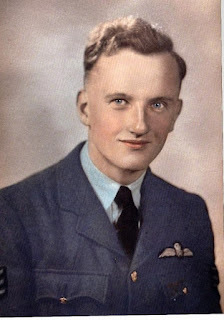
Stevie was born poor — on December 14, 1921. His father worked for the Railway and his mother in a factory, and Stevie (then still known as Sid) started his first job at the age of eight, delivering goods for the local grocer. But life wasn’t all bad. Stevie belonged to a choir and joined the Boy Scouts. Meanwhile, his father was determined that he would get a better, cleaner job that the one he had and encouraged Stevie to be good at school. This paid off in a scholarship to a grammar school in the larger town of Bideford. He commuted the eight miles daily, walking two and half miles each way, and covering the remaining distance by rail; because of the train schedule, he was rarely home at night before six pm — often cold and wet.
In 1933, Stevie’s family moved to London, where his father had a better job as an engineer on electrical locomotives. Stevie was allowed to transfer to the Henry Thorton grammar school in Clapham Common, where (he says) some of the students were “fairly posh, but not too posh.” At fifteen, he obtained his school leaving certificate with commendable results and would have liked to continue in the sixth form — but his father could not afford to keep him in school. It was time to start “earning his keep.”
With good recommendations, Stevie landed an office job in the Estates, Housing and Valuations Department at Croydon in 1937 earning 17 shillings and 6 pence (less than a pound) a week. Already convinced a war was inevitable, in 1938 Stevie tried to join the RAF Volunteer Reserve (RAFVR) but was turned down because he didn’t have the right accent; the RAF preferred “public school types.” So he joined the Air Raid Precautions (ARP) Service instead. He was on duty the night his own house suffered a direct hit during the Blitz. His parents and an uncle, who had stopped by for a cup of tea had all survived in the shelter, but Stevie lost everything he owned except the clothes he was wearing. Stevie later claimed:
“I looked up at the empty sky and said to myself: ‘You bastards, what a bloody awful thing to do, I’ll get my own back on you for this.’ I knew straight away I wanted to be a bomber pilot; not many people wanted to fly bombers, but I knew that I did and I was determined that I would.”
In April 1941, Stevie again applied to the RAFVR and was accepted as an “Aircraftman” and mustered for pilot training — after he’d completed the induction process and, of course, survived six weeks of “square bashing” learning to salute and march, while also receiving instruction in morse code, theory of flight and navigation, aircraft recognition and more. Stevie remembers the course as “demanding” and failure meant “remustering” for a trade other than pilot. At the end of six weeks, only 60% passed. Further training, including clay pigeon shooting, followed. It was October 1941 before Stevie arrived in Carlisle for “Elementary Flying Training” and his first ever flight in an aeroplane. One month later, Stevie was among the lucky candidates not to be “washed out” and could proceed with pilot training.
To Stevie’s astonishment, he was slated for training in the United States. Mid-December he was aboard the SS Bergensfjord found for Halifax along with hundreds of other aspiring pilots on their way to training establishments in Canada as well as the U.S. At Halifax they were taken to a central “dispersal unit” for assignments. Here, even in the middle of the Canadian winter, Stevie enthused about the quality of the accommodations, the abundance of food and the lack of black-out. In early January, Stevie proceeded to “No 2 British Flying Training School” in Lancaster, California. Despite it’s designation as a “British Flying Training School,” the school, “War Eagle School,” was a civilian flying school established under the U.S. government Civilian Pilot Training Program. All the instructors were civilians, although RAF personnel had administrative and disciplinary responsibility for the RAF trainees, and an RAF flying instructor did the final testing of candidates.
From February to August 1942, Stevie advanced steadily through the various challenges of Primary and Advanced Flying training, including night flying, instrument flying, cross-country navigation, aerobatics and more. On 4 August, Stevie received his “wings,” symbolizing his qualification as an RAF pilot. Yet Stevie’s letters of this period talk as much (if not more) about the lavish hospitality he enjoyed from Americans. He was invited into people’s homes, taken sailing and riding, given tours, introduced to celebrities, and enjoyed the chaste company of nice American girls charmed by him (and his accent, no doubt!). He describes barbeques and scrimp cocktails, swimming parties in private pools and swimming in the Pacific, horse shows, films and shooting. He tells of a host with a private airplane that allowed the (not yet qualified British cadets!) to fly back to their airfield, when it looked like they might be late on weekend. He would never live so well again!
At the latest, when Stevie boarded the Queen Mary in her grim wartime camouflage paint and wartime fittings as a troop transport, reality started to set in again. He arrived back in England on September 11 1942 and less than two weeks later had his first flight in a twin-engine aircraft as part of his next stage of training. In October he was sent to an Operational Training Unit (OTU) to start learning to fly operational aircraft, in this case the Wellington. It was here that he “crewed up” with a navigator, bomb aimer, wireless operator and rear gunner. Six months later, the entire crew advanced to the Heavy Conversion Unit (HCU) where a Flight Engineer and a mid-upper gunner joined them. At the end of them month, they were posted to an operational squadron, No 57 at RAF Scrampton. Stevie started his operational tour as a Sergeant Pilot.
1 May and 20 October 1943, Stevie flew a total of 31 operations. Targets included: Duisberg, Dortmund, Duesseldorf, Bochum (2x), Cologne (3x), Krefeld, Gelsenkirchen, Hamburg (2x), Manheim (2x), Nuremburg (2x), Munich, Stuttgart, Leipzig, Essen, Hannover (3x), Berlin (3x), Turin and Milan (2x). Stevie was flying at the height of the so-called Battle of the Ruhr (Happy Valley) and the beginning (or prelude) to the Battle of Berlin. He was flying in a period when Bomber Command losses were at their peak. On 57 squadron in this period, only 20% of crews survived an operational tour. In the RAF as a whole, 669 aircraft were shot down over enemy territory, while others crashed on landing as a result of damage sustained on operations or due to poor weather. Others were lost in collisions due to the very dangerous conditions of operating at night without navigation lights in a loose “bomber stream.” Although occasionally one or two men survived being shot down or crashing, the loss of all seven men on board was more common.
Stevie later described the experience as follows:
An operational tour seemed like a series of thirty very testing examinations, requiring skill, intelligence and a grim determination to succeed. A momentary failure to concentrate and react swiftly usually resulted in death…Yet morale was invariably high.”
On another occasion he wrote:
“I was always astonished by the lack of panic among the aircrew who flew on tours. … It was pretty obvious that we couldn’t all survive, and when you looked around the table at a briefing for 18 – 20 crews, you knew darn well the next day that at least two or three wouldn’t be coming back, and perhaps more. As the Captain, you would come out and tr to make a joke or a comment just to lighten the mood and to keep up the morale of your crew.”
For Stevie, it was this concern for his crew that dominated his thoughts and determined much of his behaviour. A deeply spiritual and devout man at heart, he prayed before each flight: “God grant that I may never fail my crew and that I may ever fulfil the trust they place in me.” His concern for his crew manifested itself in how conscientiously he did his job, but also in the fact that to the end of his life his lost comrades remained spiritually with him. His son remembers that the first time he went to vote, his father (Stevie) told him: “A lot of my friends gave their lives so that we can do this, and a lot of them were younger than you.” On another occasion he wrote:
“The world we did our bit to bring about is, for all its problems, an infinitely better place than the world subjected to Nazi tyranny. That is Bomber Command’s legacy to the young men and women of today, and it is a true memorial. They laid down their lives so that you could live yours in peace and freedom.
But Stevie showed his respect and concern for his crew in other ways too. When his rear gunner suffered from PTSD following a particularly harrowing sortie in which the Lancaster had sustained severe damage, Stevie could not risk flying with him, but he would not hear of him being posted for “Lack of Moral Fibre” (LMF) as was then common. Instead, he not only asked the Squadron CO to stand him, in his own words, he: “I suggested to my CO that [the gunner] might be commissioned and so avoid being discharged and demoted as LMF. The CO tore me off a might strip for being so bloody impertinent….” But he was successful. The gunner was commissioned and later returned to operational flying.
Stevie ended his tour as a Pilot Officer, having been promoted on 4 July 1943 after eight operational sorties. He received an immediate DFC, more for his entire tour than for an individual act of bravery. He was 22 years old and planning to marry in December. His wife was a WAAF, a Radio/Telephone operator in Flying Control. She was one of the first women trained and posted for this trade and the RAF was still adjusting to it. When diverted to a different field due to a shortage of fuel, Stevie received instructions to land from a woman the first time in his life. On landing, he went straight to the Control Tower hoping to make a date with the WAAF — only to find her surrounded by pilots much more senior than himself. (He was still a sergeant at the time.) Luck was on his side, however, because just days later the WAAF R/T operator was soon transferred to his own station. When her voice again gave him instructions, he recognized it at once, and went straight to the tower to ask her out! Her name was Maud “Maureen” Miller.
Shortly after her transfer, Maureen was on duty the night 617 Squadron returned from the raid against the Ruhr dams. She talked in all the returning aircraft of the squadron, something that made her a “celebrity” later in life although to the end, she consistently pointed out she was only doing her job. While she was friendly with many of the 617 pilots, she fell in love with Stevie. Maureen remembers him saying: “If I’m still alive at the end of the year, we’ll get married.” He was, and they did. They stayed together more than seventy years until Maureen’s death the day before their 74th wedding anniversary in 2017.
But they could not know that in December 1943 — a dark period of the war. The bombing offensive against Berlin was at its peak and taking a terrible toll. The Allies had not yet landed in Normandy. The end of the war was not in sight. Stevie, however, was due for at least a break from operations and his next assignment was as an instructor at an OTU, training pilots on the Wellington. (Note: the photo below was taken just six months after the one above.)
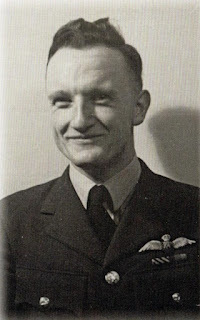
Stevie recalls that the reception at the OTU was cold and he was at first found the Wellington a bit of a comedown after flying Lancasters, but he soon came to appreciate the flying qualities of the Wellington and its suitability for training pilots on the principles of night operations and preparing pilots to fly the heavy bombers. Training was dangerous. Roughly 5,000 RAF aircrew died in training accidents in the course of the war. Many instructors became victims of student pilots’ mistakes. But Stevie proved a gifted instructor — unlike many former operational captains. He was so good at instructing that he was not asked to return for a second tour and did not volunteer himself. He had found his niche.
Stevie was sent to the instructors course to become an instructor of instructors. When the war ended, he was not released but instead promoted to Flight Lieutenant. He was also sent on additional training courses after which he was assigned as Wing Adjutant, Station Adjutant and Chief Ground Instructor. Increasingly, however, his students were not young pilots learning their trade but returned POWs. These men were often highly experienced pilots, many of them much more senior than Stevie, some of who had been in POW camps for years. Those who had been prisoners of the Japanese had often suffered malnutrition, physical abuse and psychological torture. Some recognized the need for a “refresher course” in flying; some didn’t. It was not until October 1947 that Stevie was “demobbed” with the rank of Flight Lieutenant on the condition that he remain in the RAFVR.
Stevie, however, had his eye on turning his proven talents as an instructor into a career in teaching. He attended a teacher training college and, after qualifying, took up work at secondary schools teaching Science and Maths. It was a career he was to pursue successfully for nearly forty years with great success — as the testimonials of many of his former pupils attest.
Stevie’s RAF career was exemplary in more ways than one. He came from a humble background, bucked the prevailing class prejudices of the era and took advantage of the RAF’s comparatively merit-oriented culture to attain first command and then rank and recognition. He “did his job” as a bomber pilot, yet it was as an instructor that he really stood out and it was as a teacher that he impacted the lives of thousands for the better.
(The information in this bio is drawn from Tomorrow May Never Come: The Remarkable Life Story of ‘Stevie’ Stevens, Lancaster Pilot and Beloved School Teacherby Jonny Cracknell and Adrian Stevens. This biography is available for purchase at: https://jonnycracknell.com/tomorrow-m... )
My novels about the RAF in WWII are intended as tributes to the men in the air and on the ground that made a victory in Europe against fascism possible.
Lack of Moral Fibre, A Stranger in the Mirror and A Rose in November can be purchased individually in ebook format, or in a collection under the title Grounded Eagles in ebook or paperback. Find out more at: https://crossseaspress.com/grounded-e...

Where Eagles Never Flew was the the winner of a Hemmingway Award for 20th Century Wartime Fiction and a Maincrest Media Award for Military Fiction. Find out more at: https://crossseaspress.com/where-eagl...

February 11, 2022
FORGOTTEN HEROES -- A SOUTH AFRICAN IN ATHENS: SQUADRON LEADER PAT PATTLE DFC
Squadron Leader “Pat” Pattle DFC & Bar is most commonly remembered as the highest scoring “ace” of the RAF in WWII. Yet my reason for including him in this (totally subjective and highly personal) series of “Forgotten Heroes” is his service to my adopted country: Greece.
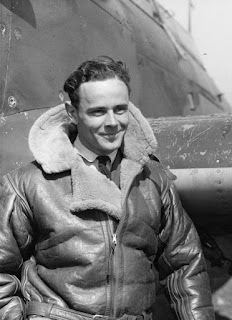
“Pat” Pattle was born 3 July 1914 in South Africa, the son of British South Africans, and named after his paternal grandfather Marmaduke Thomas. As a boy he went by “Tom.” His grandfather had been a captain in the Royal Horse Artillery before emigrating to South Africa in 1875. Pattle’s father also served in the Boar War, fought in the Natal Rebellion and again in the First World War. He served briefly in the police force before taking up farming in South West Africa. Here Tom grew up learning how to fend for himself in the desert and how to shoot very well.
Tom went to school in boarding school in Grahamstown and graduated in 1931. Although he already wanted to learn to fly, the South African Air Force turned him down because he did not already have flying experience (as other candidates did). He worked as a mechanic in a petrol station and he took a course at a commercial college that eventually led him to a clerical job and from there to a laboratory job with a gold mining company. He liked the latter work well enough to consider pursuing a degree in mining engineering, but an encounter with an aircraft — his first in the flesh — and a “flip” given by the pilot turned his head. He quit the mining company and joined the Special Service Battalion of the South African army in the hope of getting into the South African Air Force via the “back door.”
Instead, he saw an announcement in a newspaper that the RAF was offering short-service commissions to young men with a school-leaving certificate who otherwise met their criteria. Pattle immediately applied, passed the screening interview in South Africa and his uncle paid for his passage on a steamer to London to face the RAF Selection Board. Although at the time he hoped for a career in aviation, either through a permanent commission in the RAF or in civil aviation, Pattle could not know that he would never see his homeland or his family ever again.
Two weeks after his arrival, Pattle had been accepted for training and reported to the Civil Flying School at Prestwick at the end of June 1936. Here he introduced himself as “Pat” for the first time, and the name stuck with him throughout his RAF career. He proved a natural pilot, who soloed early and easily, and hen he completed training in March 1937, his flying was rated “exceptional.” Furthermore, he was conscientious about studying, something that resulted in consistently high scores on his written examinations. Meanwhile, his accurate shooting astonished his instructors.
At the end of training, he was post to No 80 (Gloucester Gladiator) Squadron and promoted to Pilot Officer on 27 July 1937. In October, he had already been appointed Squadron Adjutant, a tribute to his reputation as hard-working, serious and reliable. Less than a year later, No 80 Squadron was transferred to Egypt to defend the Suez Canal against growing Italian aggression. For Pat, this was a step closer to home, and he welcomed the move.
At the outbreak of the Second World, the squadron was moved to the Libyan border. In the lull before the real fighting began, Pat focused on improving his physical condition and trained himself to “see” better by systematically searching the sky. He also took a keen interest in the condition of his aircraft, spurring his ground crew to greater efforts, despite the very high standards already provided.
On 4 August 1940 — while the Battle of Britain was still in the early phases — Pat experienced combat for the first time. Although the squadron was slowly being equipped with Hurricanes, Pat’s flight still flew the bi-plane Gladiators. In an encounter with Italian aircraft, Pat claimed his first victory, an Italian Breda bomber, but was himself shot down when after several dog-fights he was confronted by an entire squadron of Italian Fiat CR-42s. With his guns already out-of-action from the earlier dogfighting, Pat attempted evasion, but the Italians got the better of him, shooting up his rudder. Pat took the badly damaged aircraft up to 400 feet and there jumped out over the desert.
At the time he bailed out, he was only a few miles behind enemy lines. Unfortunately, he became disoriented in the desert and walked in the wrong direction much of the night. It was noon of the following day before he crossed back into Egypt. Here he had the good fortune to be picked up by a passing column of the 11th Hussars.
This experience left a psychological mark on Pat. He became determined never to be shot down again — at least not by Italians — and not to get lost again either. He purchased a compass to carry with him in the pocket of his tunic. The experience had not, however, daunted his aggressive spirit.
On 8 August 1940 the entire squadron took the war deep into Italian air space consciously seeking battle. Divided into four sections flying at different altitudes, they lured the Italians into a fight and then efficiently executed them. A total of 15 Italian fighters were claimed for the loss of two Gladiators, and only one pilot. Less than a month later, the Italian invasion of Egypt began, and on 28 October Italy invaded Greece as well.
While the Greek army rapidly proved capable of defending the mountain passes in the northwest of the country, the Greek Air Force consisted of just 200 aircraft, all of which were obsolete, while the Italians onslaught was supported by 2,000 modern aircraft. The Greek government appealed to Great Britain for aid, and the British government responded by sending two Blenheim and one Wellington squadrons. These succeeded in completely disrupting the Italian lines of supply and communication, while the Greek — poorly equipped as they were — went on a savage counter-offensive that threw the Italians out of Greece within a week.
The conflict still raged, however, and the RAF bombers had suffered significant losses. They needed fighter protection. So, No 80 Squadron was pulled out of the desert and sent to Athens arriving 16 November 1940. They were received by the Greeks with cheers, waving flags and free drinks in the tavernas of Athens. The next day they continued to Trikkala, where the three remaining Greek pilots at the field introduced them to their new environment by leading them toward the nearest Italian base. The Greeks did not have the fuel to engage, but 80 Squadron went on the offensive and downed nine Italians. It was an encouraging start, which made them even more popular with the locals.
However, torrential rains and low cloud precluded flying in the succeeding days, and the squadron was not displeased to be transferred another airfield, this time in Yanina just 40 miles from the Albanian border. This was another grass airfield — kept short by grazing sheep — and it possessed neither hangers nor dispersal huts. The “mess” was in a hotel in the village. With frequent rain, the aerodrome was often more lake than field, while low cloud and high winds made flying difficult and dangerous.
Despite the conditions, Pat recognized that the RAF still enjoyed conditions far superior to that of most of the Greeks. It became his custom to visit the local hospital in the evening. His biographer E.C.R. Baker describes the situation as follows:
Their work finished for the day, the pilots went off to visit the many Greek wounded soldiers housed in shocking conditions in the local hospital. It was so overcrowded that there was hardly room to move between the closely-packed beds. … The pilots shared their cigarette rations with the unfortunate Greeks, and brought some cheer amidst the miserable surroundings. … The tears in the eyes of these cheerful, hardy people, and their sincere cries of ‘Good luck, Inglisi,’ …. gave the pilots that little extra incentive and dash which made all the difference in any unequal battle.” [Baker, Ace of Aces. Silvertail Books, 2020, 113-114]
Soon afterwards, the squadron was relocated to Larissa, which had a better airfield. Here they flew frequent escort flights for RAF bombers during which the Gladiators were subjected to heavy flak. Such heavy flak, in fact, that by 6 December the entire squadron had to be stood down while repairs were undertaken. Despite working around the clock in appallingly cold and wet conditions, it took the ground crews a week to render the aircraft serviceable again. Yet even as No 80 squadron took an enforced break from the action, the Greek army was advancing through Albania, remorselessly pushing back the Italians. This advance was described vividly by American journalists that witnessed it as follows:
“…open carts, pulled by sturdy little mules, and driven by cheerful Greeks, protected from the driving rain and wind by a single piece of canvas, ploughing through the mire. Here and there a cart was held fast by the clinging mud, and the old men and women, and even small children, were scrambling around the hillsides searching for stones and branches to make the road passable again.” [Baker. 121-122]
On 21 December, Pat’s CO, Squadron Leader Hickey, was shot by the Italians after taking to his parachute. Members of his squadron saw him bail out, saw the Italians attack and the saw parachute catch fire. It was the second incident of this sort in just three days. Pat was de facto Acting Squadron Leader after Hickey’s death and improvised a Christmas celebration which included a Christmas tree decorated with candles — and trophies from shot-down Italian aircraft.
After ten days of leave, which he spent with friends in Cairo, Pat returned to Greece. By now the winter had really set in. When the squadron attempted to return to Yanina, the convoy with their ground crews ran into a blizzard.
“…a blinding snowstorm brought the lorries to an abrupt standstill. The airmen huddled together for warmth behind the thin canvas covering on the truck… [T]he officer in charge, Pilot Officer Patullo, immediately made arrangements to evacuate the airmen to the village of Malekas, a tiny hamlet eight miles away at the foot of the mountains. The local villagers, tough sturdy peasants, received the men with open arms, providing them with bowls of hot, steaming soup, thick black boiling coffee, and warm blankets in front of a blazing fire. Without this help, most willingly given by the cheerful, hardy people, some of the men would almost certainly have perished in the arctic conditions prevailing in the mountains.” [Baker, 142]
The squadron abandoned the attempt to relocate to the north and remained based in the Athens area. From here they continued to inflict damage on the enemy — to the extent they could in their aging Gladiators. On 8 February 1941, Pat received the DFC in recognition of his dogged determination and success in shooting down (by this point) more than 15 enemy aircraft. The official citation noted “he has been absolutely fearless and undeterred by superior numbers of enemy.” Although not noted by the official citation, Pat also showed exceptional dedication to the men serving under him, repeatedly personally carrying out searches for missing pilots, regardless of the weather.
Shortly afterwards, Pat was given the first six Hurricanes assigned to the squadron and sent to Paramythia to operate from here. On 28 February in a combined operation of 80 and 112 squadrons, 27 Italian aircraft were destroyed and eight damaged in a single engagement for the loss of a single Gladiator. Pat contributed to the total score by bringing down three Italian fighters.
On 12 March 1941, Pat was promoted to Squadron Leader and posted as CO of No 33 Squadron. Thirty-three squadron had been in the Middle East longer than 80 Squadron and was made up mostly of regular officers but from vastly different backgrounds, including a Rhodesian, Kenyan, Canadian and another South African already. They were individualists, proud of being disrespectful of authority, and Pattle told them they looked scruffy and lacked flying discipline. However, they had also all been flying Hurricanes for six months rather than only a few weeks. Pattle used this to his advantage by suggesting he needed some practice dogfighting. This gave his new command an opportunity to judge his flying abilities — and he gained their respect in a spectacular dogfight with the pilot from 33 Squadron the others had thought best capable of "defeating" him.
On 22 March, No 33 squadron went operational from the airfield in Larissa — a town no longer recognizable because it had been all but flattened by an earthquake and Italian bombing. The following day, 33 Squadron escorted Blenheims on a bombing raid. On 6 April, Germany invaded Yugoslavia and entered the conflict with Greece. The same day, on an offensive patrol over Bulgaria, Pattle encountered the Luftwaffe for the first time in his career when No 33 Squadron took on a squadron of Me 109s. The outcome: five Luftwaffe fighters shot down without losses to the RAF. In the days to follow, Pattle and his pilots continued to give far better than they took. In total, in the fourteen days following the German entry into the war, Pattle shot down between 25 and 35 enemy aircraft. (The official records have been lost precluding a definitive count.). On three separate days, he claimed five enemy aircraft shot-down, and on 19 April he claimed his largest number of victories in a single day: six.
But the situation on the ground looked completely different. Outflanked by the advancing Wehrmacht, the Allied ground forces were forced to pull back — initially to Thermopylae. All airfields north of this point, including Larissa, had to be abandoned. Only three airfields remained opened, one immediately south of Thermopylae and two in the vicinity of Athens. From these, the remaining RAF fighters tried to protect the retreating Allied troops, but their airfields came under increasingly frequent and devastating attacks from the Luftwaffe.
By 20 April 1940 the British and Allied forces were preparing a seaborne withdrawal from Greece. The Luftwaffe ordered concentrated attacks on the congested shipping in Piraeus Harbour — including dive bombing a hospital ship. To stop them, the RAF had only 15 serviceable Hurricanes left. Despite suffering from a high fever and chills, Pattle took off. He downed one Ju88 and two Me109s, but he paid with his own life. He was one of four RAF pilots killed in this engagement, known as the Battle of Piraeus.
Pat Pattle had left South West Africa to learn to fly and ended up dying over Athens in a conflict that only tangentially impacted his country's fate. It would have been easy for him -- and his parents -- to feel misused and resentful. Yet his letters and his actions suggest rather that he identified strongly with the Greek people and fought out of a sincere conviction that he and his men were engaged in a just struggle -- one worth the sacrifices made.
Winston Churchill famously said when speaking of the Greek defiance of fascist Italy and Nazi Germany: “Hence we will not say that Greeks fight like heroes, but heroes fight like Greeks.” Pat Pattle fought like a Greek. He deserves to be remembered.
(Source: Baker, E.C. R.. Ace of Aces: The Incredible Story of Pat Pattle — the Greatest Fighter Pilot of WWII. Silvertail Books, 2020.)
My novels about the RAF in WWII are intended as tributes to the men in the air and on the ground that made a victory in Europe against fascism possible. Lack of Moral Fibre, A Stranger in the Mirror and A Rose in November can be purchased individually in ebook format, or in a collection under the title Grounded Eagles in ebook or paperback. Find out more at: https://crossseaspress.com/grounded-e...
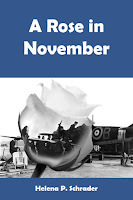
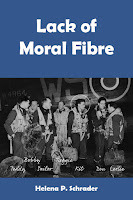
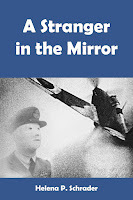
Where Eagles Never Flew was the the winner of a Hemmingway Award for 20th Century Wartime Fiction and a Maincrest Media Award for Military Fiction. Find out more at: https://crossseaspress.com/where-eagl...


